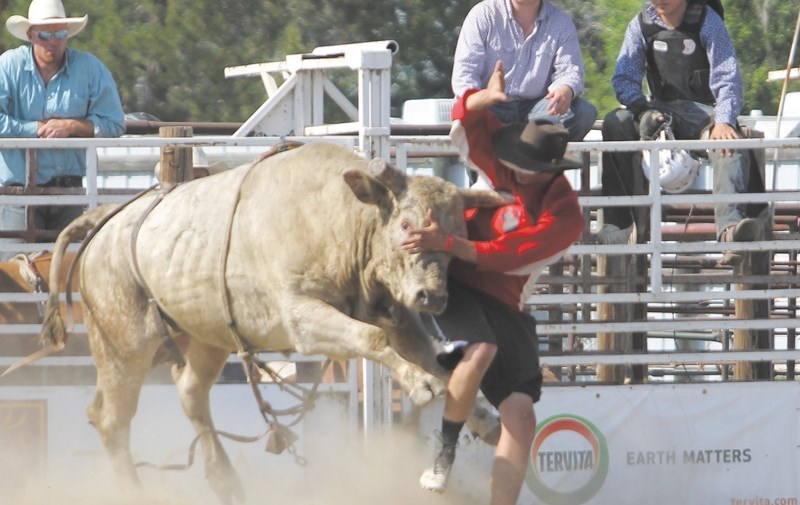It takes a different kind of person to stare down a 2,000-pound bull for fun.
Bullfighter Wacey Nash is just that kind of person. The 6’6”, 220-pound Cochrane resident has been bullriding most of his life. But for him, the rush riding gave him didn’t quite cut it.
“When you rode them you had your adrenaline; you get on and then it goes away. For when you’re fighting them… you have an adrenaline rush for 30 bulls.”
It was at Coutts Grass Rodeo on the Alberta-Montana border in 2010 that Nash got his first taste at the sport, his first ever hired gig.
“The nerves definitely got to me a bit.”
One of the first bulls he fought was called Gin and Juice: “A tiny little thing with one horn,” he recalled.
Nash estimated that the bull weighed in at no more than 1,300 pounds, but what the bull lacked in bulk, it made up in ferocity.
“That was probably the meanest bull in Canada.
“It didn’t matter if the rider came off, he was going to chase you. When he hit you, it felt like a ton of bricks.”
But through the hits, the ramming and general mayhem, Nash was hooked.
It’s a sport that dates back to the start of competitive rodeo in the early 1900s, when bullfighters were officially known as rodeo clowns, but the job has evolved into two distinct positions.
Bullfighters are tasked with protecting the riders from the animal, while rodeo clowns, also known as barrelmen or simply clowns, provide comic relief.
While clowns have to be skilled at entertaining the crowds, bullfighters require a high degree of physical fitness, mental acuity and adaptability in order to stand a chance against the bulls.
Nash used to train every Tuesday in Olds. Some nights they would ‘buck’ 20 bulls; other nights it was 50. And what made it all the more challenging was that many of the riders were new themselves.
There has to be two fighters in the field, which means teamwork is key. In the context of the sport, that means coordinating your combined actions with your partner by anticipating the bull’s movements.
“When you work with a partner, it all depends on which way the bull’s spinning, or which way you go, or where the rider comes off.”
And sometimes, the rider doesn’t just fall off.
“There’s situations where the rider gets hung up or stuck that you and your partner have to work together to get him unstuck.”
That can mean one fighter working to draw or distract the bull, while the other working to free the rider — a kind of chaotic tandem dance around the raging animal.
Nash said it’s mainly about interpreting the bull’s body language – correctly. “Mostly, what I tell people is if you can read cattle, you’ve got a good chance of getting good at this.
“Our job entirely is to make sure (the rider) doesn’t get hurt so he can go to the next rodeo. So you got to read where he’s coming off to know where you have to be.”
But oftentimes, unavoidably, that means putting yourself at the mercy of the bull. “There’s times you’re going to have to take a shot for the rider.”
Surprisingly, Nash hasn’t suffered any catastrophic injuries. He pointed to a couple broken fingers and toes as the worst he’s suffered.
But the sport is undeniably dangerous. Although there’s not much in the way of injury statistics, Nash watched a bull break his partner’s pelvis. Because of how many organs the pelvis surrounds, fractures can cause internal bleeding and be life threatening.
So with the risk, what does Nash’s wife Tracey think?
“She gets nervous if I get in a wreck, other than that she’s pretty calm and cool.”
Tracey has been involved with rodeo for much of her life as well, and Nash said she’s quite familiar with the risks as well as the rush the sport gives him.
His family is a little more brusque. “Actually they called me stupid, because they said when you ride the thing, you only have to get away from one. Now you have to get from them all,” he said, with a laugh.
But he knows and accepts the risks. In fact, that’s the whole basis of bullfighting – accepting that there is always inherent danger. It’s just part of the job, and a job he’s happy doing. He put it bluntly: “You gotta have big balls.”




